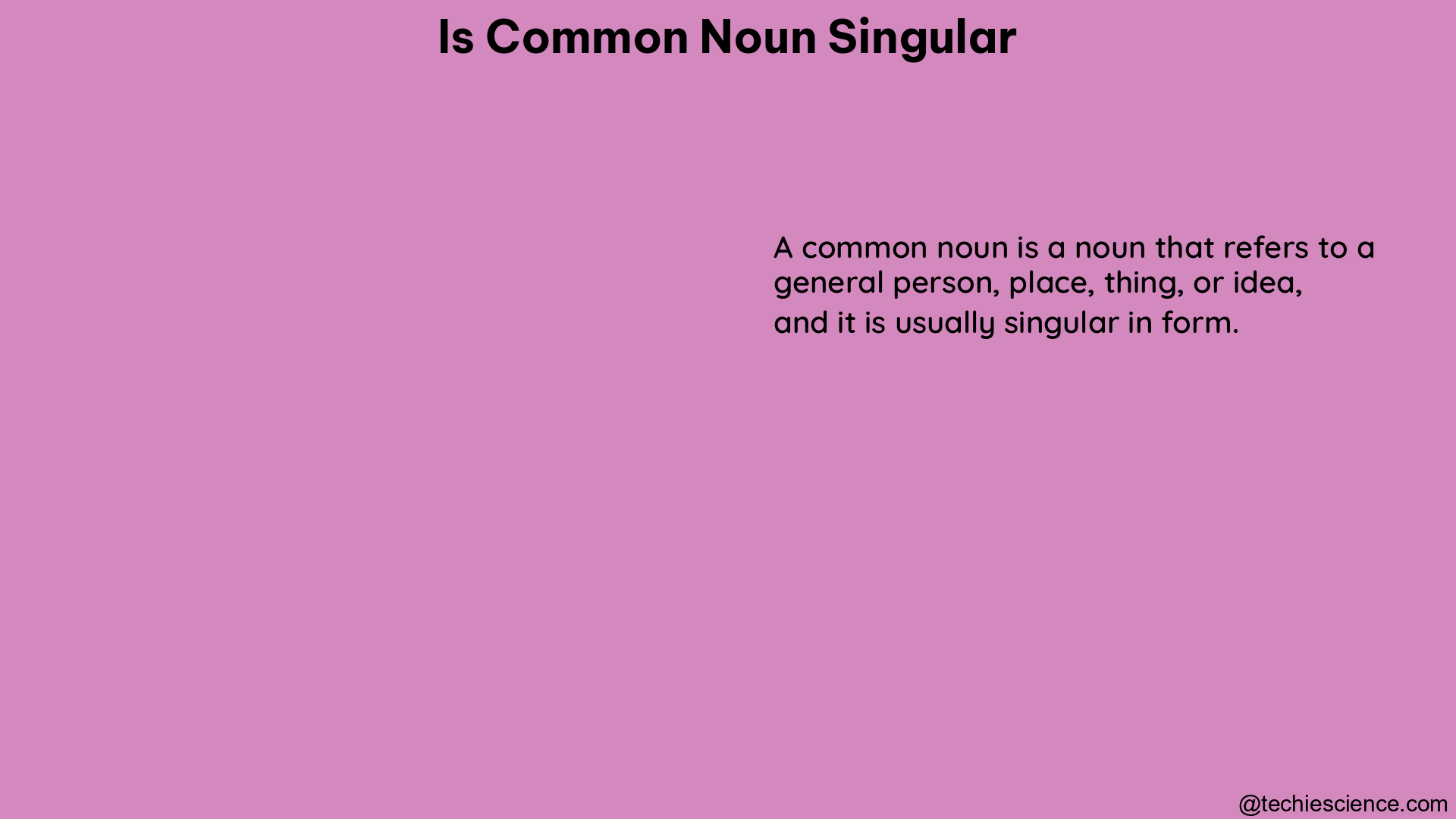A common noun is a word that represents a general person, place, thing, or idea, rather than a specific one. Common nouns can be both singular and plural, depending on whether they refer to one or more instances of a category. Understanding the singular and plural forms of common nouns is crucial for effective communication and proper grammar usage.
Singular Common Nouns
Singular common nouns refer to a single person, place, thing, or idea. They are typically used to describe a specific, individual entity within a broader category. Here are some examples of singular common nouns:
- Person: man, woman, child, student, teacher
- Place: city, country, park, school, hospital
- Thing: book, car, apple, chair, computer
- Idea: love, happiness, freedom, knowledge, creativity
In sentences, singular common nouns are often preceded by the definite article “the” or the indefinite articles “a” or “an.” For example:
- The man walked down the street.
- A dog is playing in the park.
- The book is on the table.
- Love is a powerful emotion.
Plural Common Nouns

Plural common nouns refer to multiple instances of a person, place, thing, or idea. They are used to indicate more than one of a particular category. To form the plural of most common nouns, you add an “s” or “es” to the end of the word. Here are some examples of plural common nouns:
- People: men, women, children, students, teachers
- Places: cities, countries, parks, schools, hospitals
- Things: books, cars, apples, chairs, computers
- Ideas: loves, happinesses, freedoms, knowledges, creativities
In sentences, plural common nouns are often preceded by words like “the,” “some,” “many,” or “these.” For example:
- The men walked down the street.
- Some dogs are playing in the park.
- The books are on the table.
- Loves are powerful emotions.
Irregular Plural Common Nouns
While most plural common nouns are formed by adding “s” or “es,” there are some irregular plural forms that do not follow this pattern. These irregular plurals are often derived from Latin or Greek roots. Here are some examples of irregular plural common nouns:
- Person: man → men, woman → women, child → children
- Thing: mouse → mice, goose → geese, tooth → teeth
- Idea: datum → data, medium → media, criterion → criteria
In sentences, these irregular plural common nouns are used in the same way as regular plural common nouns:
- The men walked down the street.
- The mice are running in the walls.
- The data are stored in the computer.
Collective Nouns
Collective nouns are a special type of common noun that refer to a group of individuals or things. These nouns can be used in both singular and plural forms, depending on the context. Some examples of collective nouns include:
- Groups of people: team, family, class, audience, committee
- Groups of animals: herd, flock, swarm, school (of fish)
- Groups of objects: set, series, collection, group
In sentences, collective nouns can be treated as either singular or plural, depending on whether the focus is on the group as a whole or the individual members within the group. For example:
- The team is practicing for the game. (Singular)
- The team are arguing with each other. (Plural)
- The herd of elephants is moving across the savanna. (Singular)
- The herd of elephants are eating the grass. (Plural)
Capitalization of Common Nouns
It’s important to note that common nouns are not capitalized unless they are the first word in a sentence or part of a proper noun (e.g., a person’s name or a specific place). This is in contrast to proper nouns, which are always capitalized.
For example:
- The dog is playing in the park.
- John went to the City of New York.
- The Eiffel Tower is a famous landmark in Paris.
Conclusion
In summary, common nouns can be both singular and plural, depending on whether they refer to one or more instances of a person, place, thing, or idea. Understanding the proper use of singular and plural common nouns is essential for effective communication and correct grammar. By mastering the concepts of singular and plural common nouns, you can improve your writing and speaking skills, ensuring that your language is clear, precise, and grammatically accurate.
References
- https://www.yourdictionary.com/articles/common-proper-nouns
- https://www.edulyte.com/english/common-noun/
- https://byjus.com/english/singular-nouns/
- https://www.grammarly.com/blog/common-noun/
- https://owl.purdue.edu/owl/general_writing/academic_writing/grammar/common_nouns.html
Hi… I am Sowndharya Jagadeeswaran, a university rank holder in M.A. English Literature. I have also done my master’s in Business Administration. Inquisitive as I am, my interest in action-oriented research helped me publish research papers in reputed journals. Now, as a career, I am an instructor where I teach young and adorable students the intricate technicalities of Public Speaking and Creative Writing. I also enjoy writing articles on topics I specialize and research in.
You can connect with me through LinkedIn.-